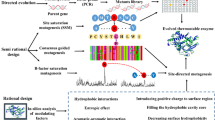Abstract
The aluminum and yeast hexokinase interaction was studied. Structural changes were correlated with variations in protein functionality. Results show two different behaviors: At low metal concentrations preferential adsorption of metal (and water exclusion) induces aggregate formation. No significant changes in the protein structure occur, but there is a continuous loss of activity (from the first concentration). At large salt concentrations a monomerization process and a conformational change in the secondary structure as well as in the three-dimensional structure take place. This change reduces the percentage of α-helix conformation, gives thermal stability to the protein, and allows the exposure of some tryptophan residue and hydrophobic regions. The protein inhibition increases. Conformational change and monomerization may allow access of the metal to the substrate site, mainly the ATP site. The inhibition in any case is of mixed type with a competitive component.
Similar content being viewed by others
REFERENCES
Alfrey, A. C., Mishell, J. M., Burks, J., Contikguglia, S. R., Rudolph, H., Lewin, E., and Holmes, J. H. (1972). Trans. Am. Soc. Artif. Internal Organs 18, 257.
Anderson, C. M., McDonald, R. D., and Steitz, T. A. (1978). J. Mol. Biol. 123, 1.
Arakawa, T., and Timasheff, S. N. (1985). Meth. Enzymol. 114, 49.
Arakawa, T., Bhat, R., and Timasheff, N. (1990). Biochemistry 29, 1914.
Armstrong, R. A., Wisper, S. J., and Blair, J. A. (1996). Dementia 7, 9.
Bennet, W. S., and Steitz, T. A. (1980). J. Mol. Biol. 140, 211.
Berger, S. A., and Evans, P. R. (1991). Biochemistry 30, 8477.
Bondy, S. C., Guo-Ross, S. X., and Truong, A. T. (1998). Brain Res. 799, 91.
Burstein, E. A., Vedenkina, N. S., and Ivkova, M. N. (1973). Photochem. Photobiol. 1, 263.
Candy, J. M., Oakoey, A. E., Klinowski, J., Carpenter, R. A., Perry, R. H., Atack, J. R., Perry, E. K., Blessed, G., Fairbairn, A., and Edwardson, J. (1992). J. Neurol. Sci. 107, 210.
Cassasa, E. F., and Eisenberg, H. (1961). J. Phys. Chem. 65, 427.
Cassasa, E. F., and Eisenberg, H. (1964). Advan. Protein Chem. 19, 287.
Chou, A. C. and Wilson, J. C. (1972). Arch. Biochem. Biophys. 151, 48.
Clauberg, M., Smith, C. B., Dang, T., Sokoloff, L., and Joshi, J. G. (1994). Neurobiol. Aging 15, 657.
Divita, G., Pietro, A., Deléage, G., Roux, B., and Gautheron, D. C. (1991). Biochemistry 30, 3256.
Dixon, M. (1953). Biochem. J. 55, 170.
Eftink, M. R., and Ghiron, C. A. (1976a). J. Phys. Chem. 80, 486.
Eftink, M. R., and Ghiron, C. A. (1976b). Biochemistry 15, 672.
Eftink, M. R., and Ghiron, C. A. (1981). Anal. Biochem. 114, 199.
Exley, C., Price, N. C., and Birchall, J. D. (1994). J. Inorg. Biochem. 54, 297.
Fuoss, R. M., and Strauss, U. J. (1948). Polym. Sci. 3, 602. Good, P. F., Perl, D. P., Bierer, L. M., and Schmeidler, J. (1992). Ann. Neurol. 31, 286.
Koseki, T., Kitabatake, N. K., and Doi, E. (1988). J. Biochem. 103, 425 (1988).
Lee, J. C., Gakko, K., and Timasheff, S. N. (1979). Meth. Enzymol. 61, 26.
Lineweaver, H., and Burk, D. (1934). J. Am. Chem. Soc. 56, 658.
Marcus, D. L., de Leon, M. J., Goldman, J., Logna, J., Christman, D. R., Wolf, A. P., Fowler, J. S., Hunter, K., Tsai, J., Pearson, J., and Freedman, M. L. (1989). Ann. Neurol. 26, 91.
McLaughlan, D. R. C., Begeron, C., Smith, J. E., Boomer, D., and Rifot, S. L. (1996). Neurology 46, 401.
Nichol, L. W., and Winzor, D. J. (1972). In Migration of Interacting Systems, Clarendon Press, Oxford.
Olmo, R., Blanco, M. D., Teijón, C., Socorro, J. M., and Teijón, J. M. (1998). Polym. Int. 47, 179.
Palmer, T. (1991). In Understanding Enzymes Ellis Harword, New York.
Perczel, A., Tusnády, G., Hollósi, M., and Fasman, G. D. (1991). Protein Eng. 4, 669.
Puri, N. R., Bhatnagar, D., and Roskoski, R., Jr. (1988). Biochem. Biophys. Acta 957, 34.
Reisler, E., Haik, Y., and Eisenberg, M. (1977). Biochemistry 16, 197.
Savory, J., Huang, Y., Herman, M. M., and Wills, M. R. (1996). Brain Res. 707, 272.
Scatchard, G. J. (1946). J. Am. Chem. Soc. 68, 2315.
Schmidt, J. J., and Colowick, S. P. (1973). Arch. Biochem. Biophys. 158, 458.
Socorro, J. M., Olmo, R., Blanco, M. D., and Teijón, J. M. (1995). J. Inorg. Biochem. 57, 293.
Stevens, J. M., Hornby, J. A. T., Armstrong, R. N., and Dirr, H. W. (1998). Biochemistry 37, 15534.
Stockmeyer, W. J. (1950). J. Chem. Phys. 18, 58.
Timasheff, S. N., and Kronman, H. J. (1959). Arch. Biochem. Biophys. 83, 60.
Author information
Authors and Affiliations
Rights and permissions
About this article
Cite this article
Socorro, J.M., Olmo, R., Teijón, C. et al. Analysis of Aluminum—Yeast Hexokinase Interaction: Modifications on Protein Structure and Functionality. J Protein Chem 19, 199–208 (2000). https://doi.org/10.1023/A:1007055719926
Published:
Issue Date:
DOI: https://doi.org/10.1023/A:1007055719926




